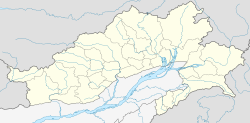This article needs additional citations for verification .(January 2015) |
Diyun Dai Yun | |
|---|---|
Sub- District | |
| Diyun HQ. Block I & II | |
| Coordinates: 27°32′42″N96°05′59″E / 27.5451°N 96.0997°E | |
| Country | |
| State | Arunachal Pradesh |
| District | Changlang |
| Government | |
| • Body | Arunachal Legislative Assembly |
| • MLA | Nikh Kamin |
| Area | |
• Total | 179 km2 (69 sq mi) |
| Elevation | 205 m (673 ft) |
| Population (2011) | |
• Total | 32,007 |
| • Density | 178.8/km2 (463/sq mi) |
| Languages | |
| • Official | English |
| • Spoken | Chakma, Hindi |
| Time zone | UTC+5:30 (IST) |
| Vehicle registration | AR |
| Literacy | 52.23% [1] [ verification needed ] |
Diyun is a small township or small city in the Changlang District of Arunachal Pradesh. It got its name from a very small, seasonal river of the same name. It is surrounded by the foothills of the Eastern Himalayas on two sides and by the Patkai Bum Range on one side. [2] [3] [4] [5] [6] [7]
Religion in Diyun (2011) [1]
- Buddhism (75.21%)
- Hinduism (20.79%)
- Christianity (2.58%)
- Others (1.42%)




